Lebanese Meat Pies (fatayer). The raw and the cooked.
Oct 20, 2014, Updated Jan 31, 2023
This post may contain affiliate links. Please read our disclosure policy.
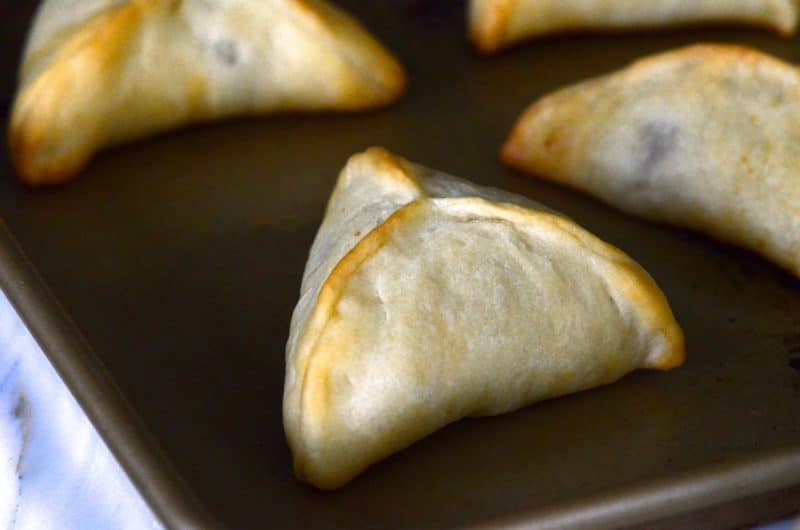
As I have discovered in the short time I’ve been married, even among the Lebanese there are differences in the ways families make their Lebanese recipes. As my teacher in culinary school used to say: likes and dislikes have a lot to do with expectations.
Take the meat fatayar (pronounced fuh-TIE-yuh). The proper preparation of the meat was a point of difference, a point of…contention?…between my parents. The Abowds, my mother’s family, they cook the meat first. It’s a way of controlling the meaty juices by cooking them off first, so that they don’t steam open the little dough triangle’s seams. Cooking first also means you can crumble the meat properly so it doesn’t clump together when it’s baked in its dough pocket.
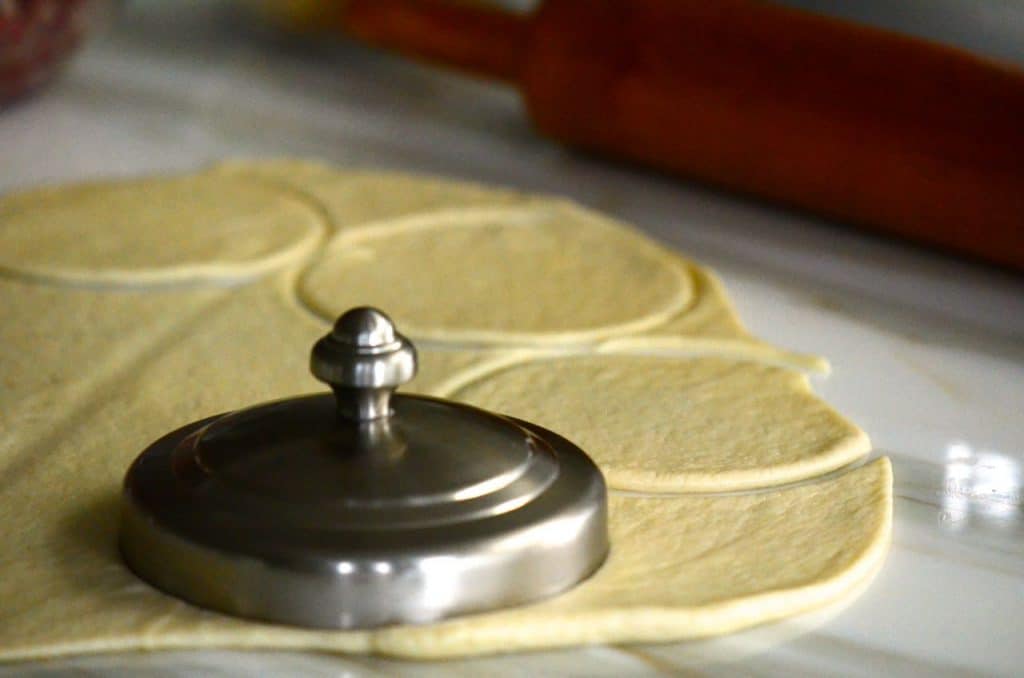
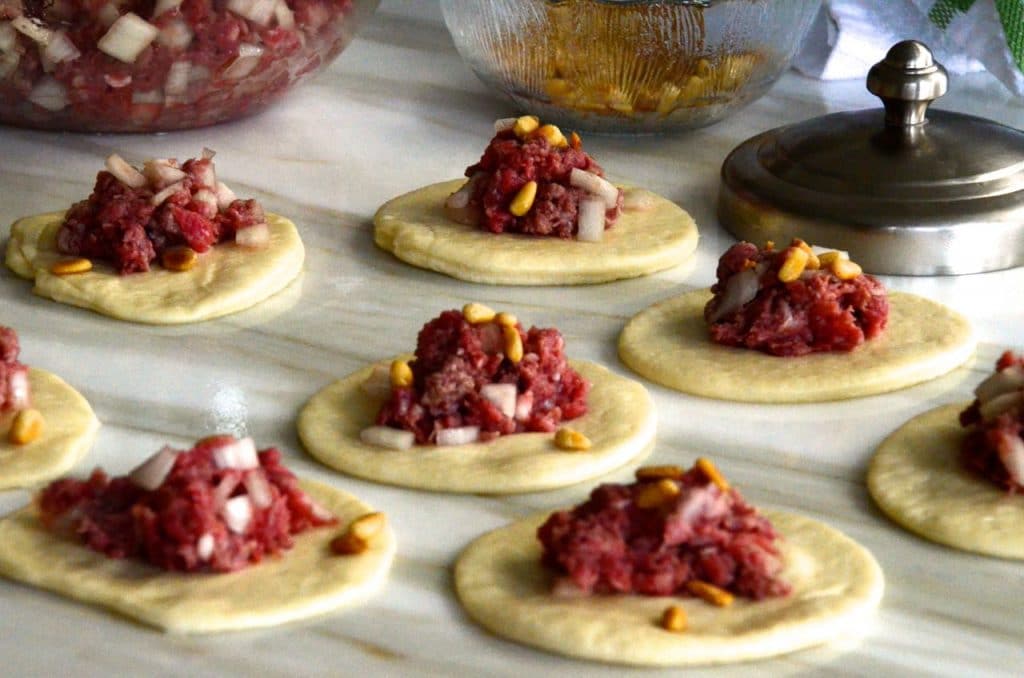
The Aboods, no. The Aboods stuff their fatayar with seasoned raw meat, seam-opening be damned for the succulent flavor the meat’s juices impart to the dough as the fatayar bakes.
The metaphor is just too delicious to ignore: the raw and the cooked. Dad’s family puts it all out there, the love and the crazy both. It’s all raw. Mom’s family is more reserved, in a most beautiful way, in a way that suggests everything is neatly cooked, properly cooked, and no seam is going to come undone.
When my Dad was so very sick from the pancreatic cancer that took his life, among the many comforting gifts of food placed before him was a platter of fatayar. They were gorgeous, my friends, not a seam undone in their perfect triangular shapes. Dad’s eyes went big when we brought the platter in, the fatayar enticing his appetite as nothing else really had. He took a bite, and basically threw the fatayar back on the plate. They cooked the meat first, he said with his mouth full of a bite he clearly, dramatically, didn’t want to swallow. He was being funny, and we laughed, but also dead serious.
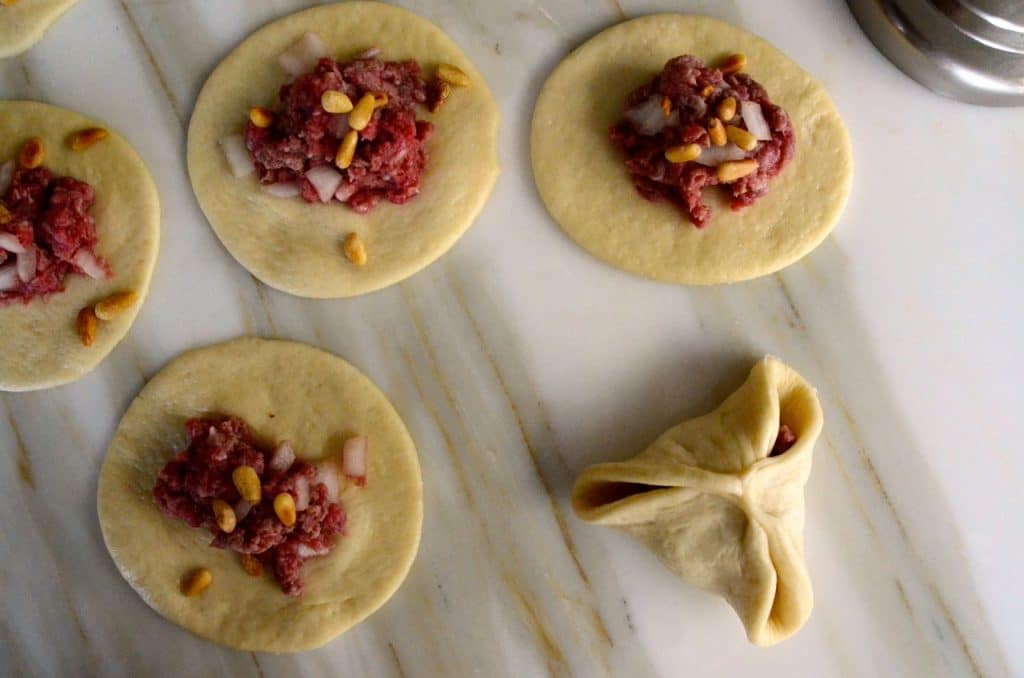

Recently when I had a visit with cousin Jimmy in Arizona, the Bianco pizza (known to be the finest in the land) I was after got moved to the back burner when we arrived because it was a Sunday, and turns out they’re closed on Sunday. I was irritated, even though I knew we’d get there the next night (obsession breeds I-want-an-oompa-loompa-and-I-want-it-NOOOOOW). Who knew I’d come to thank Chris Bianco for his Sundays off? We arrived to a home-cooked dinner of coosa and crunchy homemade pickles and labneh and olives and just-in-from-Spain marcona almonds. (yes, he’s a special cuzzy). And the showstopper: Jim’s meat fatayar. Dan did a happy dance in his soul. Fatayar over pizza, any day.
The seams on those babies were locked down tight. The flavor, out of this galaxy. Tell me about the meat, I said as Dan devoured what would be an embarrassing quantity anywhere but in a Lebanese home. Jim says coarse ground meat with a little fat is key. That keeps it from clumping since you’d never cook the meat first. Then there’d be no flavor. (Jim is Abood, obviously.)
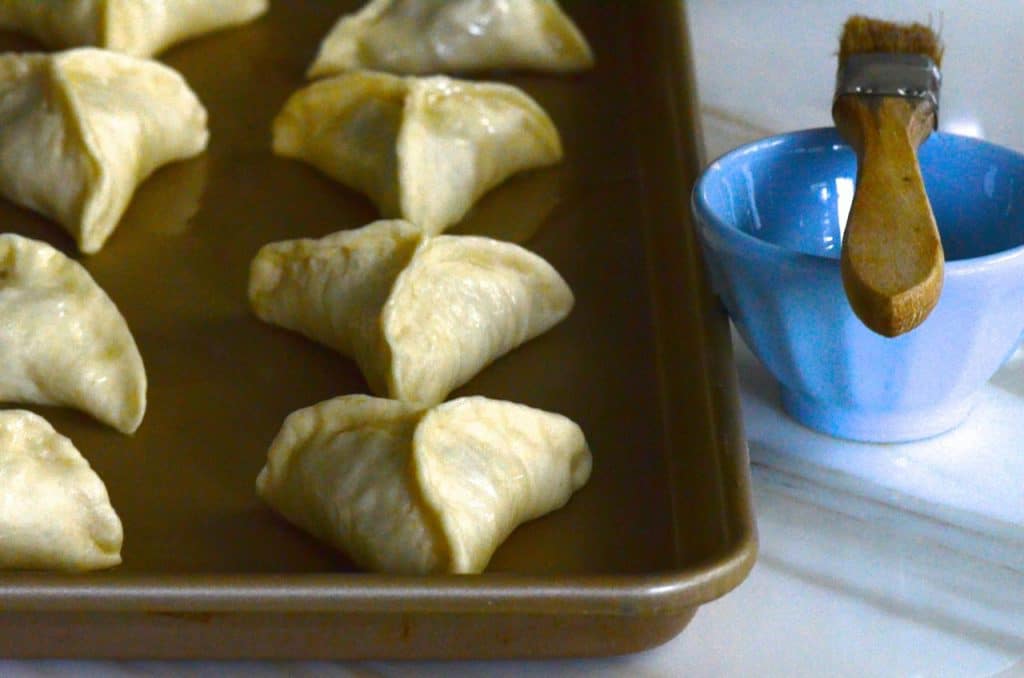
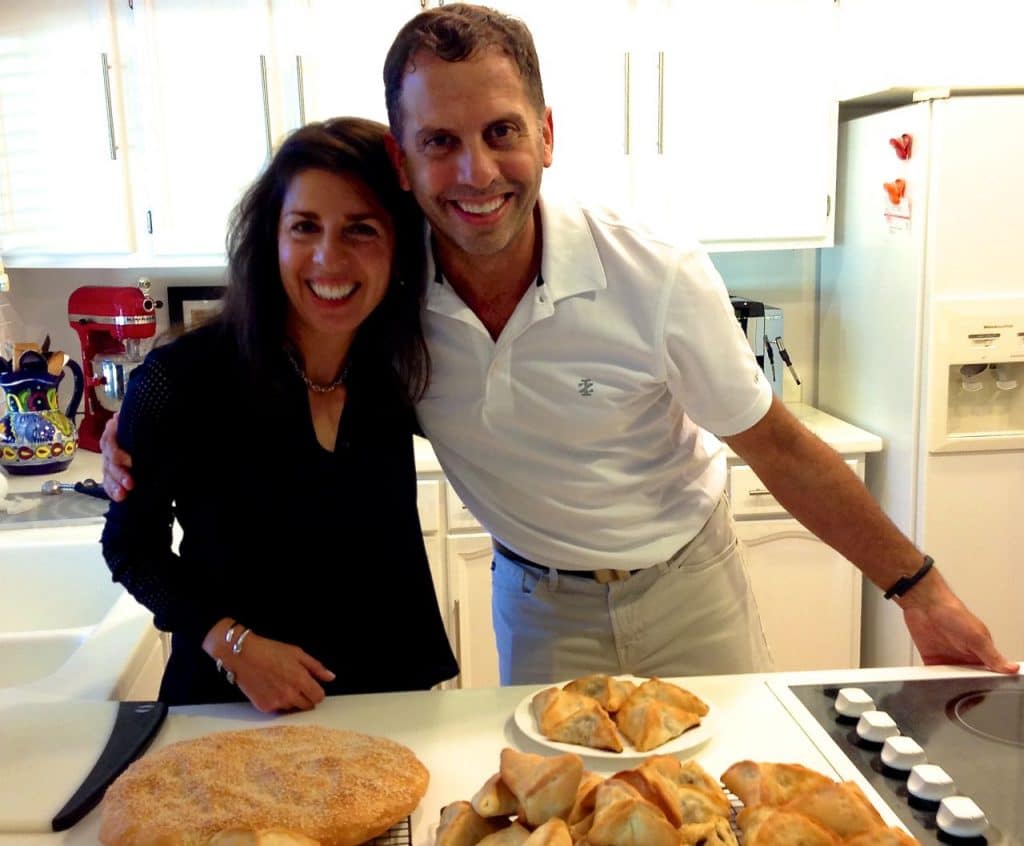
While I got religion with the coarse grind, raw, for the Lebanese sfeha recipe in my cookbook (can’t wait to share it with you in March!), those are open-faced and I hadn’t tried the raw in my fatayar, for fear of the pies opening up, the meat clumping. That Abowd-influnce, a mother’s influence, had reigned.
I followed Jim’s way here other than grinding the meat myself (he is such a purist). My mom tasted them and took her time chewing, as Abowds do. She didn’t throw it down, no drama. She simply said: Nothing wrong with it. Delicious.
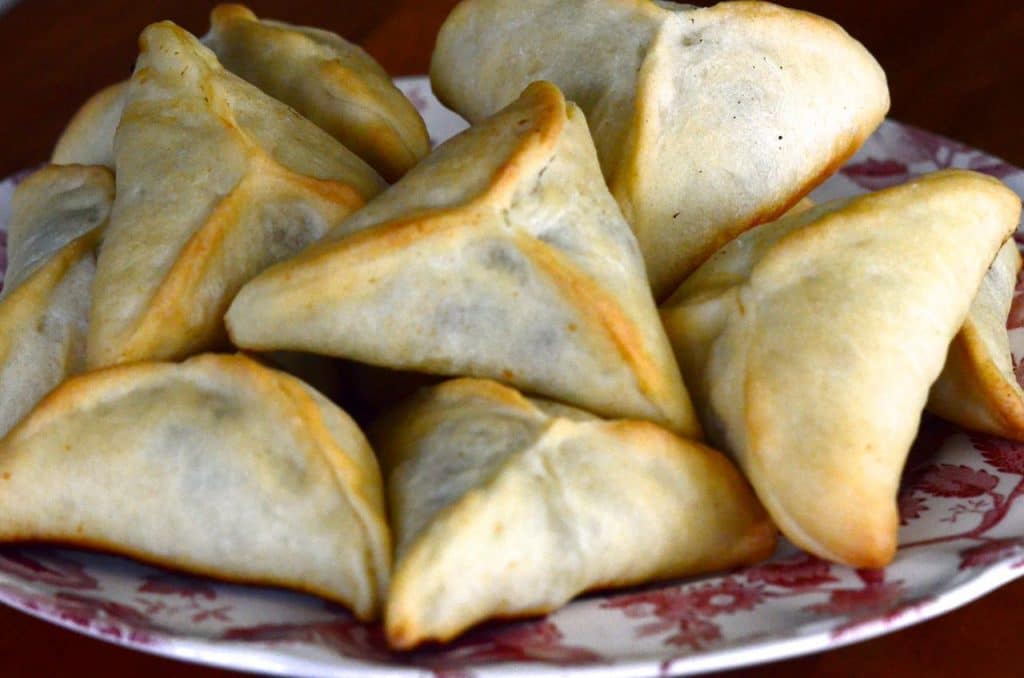
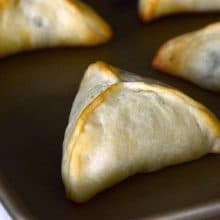
Meat Fatayar
Ingredients
For the dough:
- 1 tablespoon active dry yeast
- 1 teaspoon granulated sugar
- 1 cup warm water
- 3 cups unbleached, all-purpose flour
- 1 teaspoon kosher salt
- 1/3 cup canola or other neutral oil, such as safflower
- 2-3 tablespoons extra virgin olive oil
For the filling:
- 1/2 pound coarse ground beef chuck or sirloin, or lamb
- 1/4 teaspoon cinnamon
- Juice of 1 lemon
- 1/2 teaspoon kosher salt
- Few grinds black pepper
- 1 small sweet onion, finely diced
- 1/4 cup pine nuts, toasted
Instructions
For the dough:
- Proof the yeast by dissolving it in ¼ cup of the warm water with the sugar and letting it activate for about 15 minutes.
- Whisk together the flour and salt in a mixer bowl or medium bowl. Create a well in the center and add the oil and proofed yeast mixture. Using a stand mixer fitted with the hook attachment or by hand, slowly work the wet ingredients into the dry, adding the remaining 3/4 cup water slowly.
- Knead by hand or with the dough hook in the mixer until the dough is very soft, smooth, and tacky/sticky to the touch (but it should not leave dough on your fingers when touched).
- In a clean bowl at least twice the size of the dough, lightly coat the dough and the sides of the bowl with oil. Cover with plastic wrap and let rise in a warm spot until doubled, about 90 minutes.
To fill, shape, and bake the fatayar:
- Preheat the oven to 375 degrees. Brush two heavy baking sheets with canola oil (fine to line them with foil first for easy cleanup).
- Roll the dough out on a dry work surface to 1/8-inch thickness. Gently lift the dough from the edges to allow for contraction. Cut dough into 4-inch rounds. Knead together the scraps, cover with plastic, and set aside.
- Fill the rounds of dough by placing a heaping tablespoon of filling in the center of each round. Be careful not to let the filling touch the edges of the dough where it will be gathered together and closed. A good way to keep the filling in the center is to lower the spoon with the filling over the center of the dough (parallel to it) and use your fingers to slide the filling off the spoon and into the center of the dough circle—or just use your fingers and no spoon. Place several pine nuts on top of the filling; this method works better than adding the nuts to the filling because it’s easier to be sure each fatayar has enough nuts.
- Bring three sides of the dough together in the center over the filling and pinch into a triangle. Close the dough firmly, continuing to shape the fatayar gently as you pinch the seams closed. It’s also okay to leave an opening at the top of the fatayar.
- Place the fatayar on the baking sheets and generously brush or spray the dough with olive oil. Bake in the middle of the oven for 18-20 minutes, or until golden brown.
- Repeat the process with the other half of the dough, then with the scraps that have been kneaded together and left to rest for a few minutes before rolling out.
Nutrition information is automatically calculated, so should only be used as an approximation.
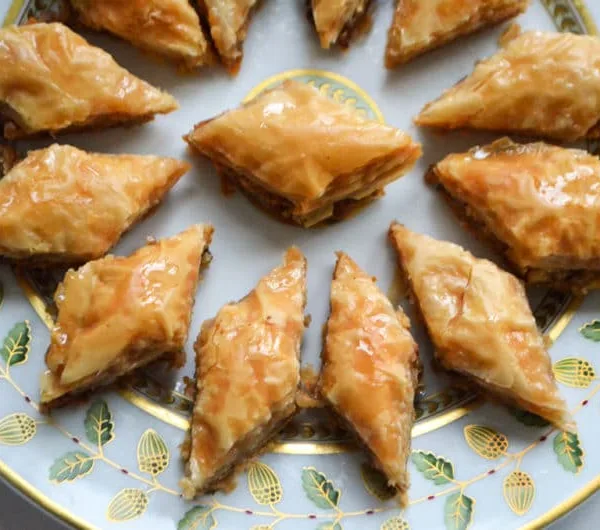

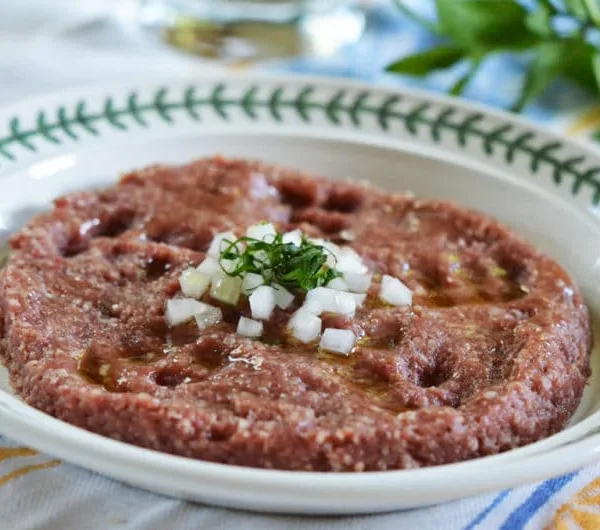
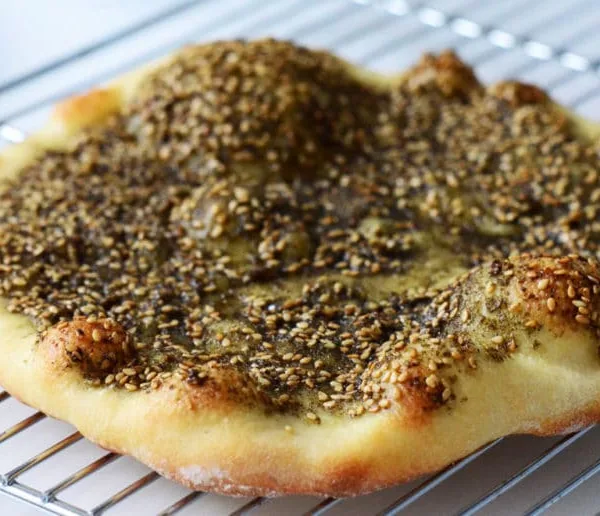







If I used spinach I have benn outting OO in the filling. Is hat OK? For some reason the edges of the dough don’t seem to stayclosed. What else could be used in a vegetarian mixture.
I have filled in all that was required, I don’t care if it’s published or not, I need to know wht the patties open while they are being cooked, and what other vegetables can be used.
Hi Norma–be sure the filling never touches the rim of the dough that is going to be closed. A spritz of water on the dough before closing them also can help. See my Spinach fatayer recipe for ingredients for that filling.
I made these meat fatayer. They are wonderful! The dough is like magic. I remember my mother getting so frustrated when making fatayer, because the grease would soak through the bottom dough, and the bottom of the fatayer would stick to the pan. Not with your magic dough. It is so easy to work with. Thanks for a great recipe.
MAGIC!!! Thanks so much Claudia. It’s so nice to have our handiwork turn out when we make fatayer.
Hi Maureen,
I am trying your recipe for fatayer today! My Siti made the absolute best Lebanese food I have ever had. Unfortunately she passed away many years ago while I was too young to realize I should have learned her recipes. To this day I have never had any that taste as good as hers. Miss her so much! Just wondering if there are any relatives out there. My Siti came here on a boat from Lebanon but did not share any information about her family. It’s my understanding that the last name was changed at customs. She went by the name Nazha Shewairy in America. My grandfather was Shikory Shewairy. Would love to meet some relatives.
Thanks so very much Bonny! This is great and I hope you find relatives!
My best friend growing up as Lebanese and her mom would make these in bulk and we would eat them in bulk. My entire adult life I could not find a recipe to replicate them until now. This recipe is absolutely perfect! I feel like I’m 12 again when I eat them (literally all of them with my husband in one sitting – these are dangerous!)
Carried I love this comment so much!!! Thank you!!
I cook these for the family like my mom did. I also get so frustrated trying to get the dough to stay closed. MY family doesn’t cared because they taste just like my moms. How do I work the dough to stay closed
Make sure the filling doesn’t touch the edges of the dough. Use a sticky dough and squeeze hard!
This sounds sooooo good! With my kids I’ve made Jamaican patties, Chinese dumplings, meat hand pies, even tamales and ravioli. Can’t wait to try your Lebanese version, most likely using beyond “meat”. They are beautiful! Thank you!!!!
Wow, you are an incredible cook! I’d love to hear how it goes with the plant-based meat, very interested.
As to my comment above…all of our Lebanese meat recipes in the family were made with lamb…only Spring Lamb. …never with any other meat and when I lived in Lebanon it was the same ..always lamb.
Delicious with lamb Dave and yes, traditional. I think it must have been difficult to come by for my forbears because not a lot of lamb was used in the recipes in our community here in Lansing Michigan.
Wonderful recipe as always!! My Mom made meat fatayers (and everything else…even bakleewee from scratch) and I do so miss her cooking !!! Mom was not Lebanese …she was old-school Boston Brahmin…but my Paternal Grandmother had emigrated from the Bekaa, never spoke English, and taught all of her daughters-in-law the traditional cuisine.
Special special!
This recipe bring back so many memories from my childhood, this is just like my mom use to make. Thank You for a delicious and great memories. Have you ever used grind pork in your also ? Mike
Pork sounds like a delicious addition Mike, thank you!!
My Tata (always thought that was the word for grandmother(?)) was a Gemayel (Jamail) from the old country. She and my aunts would make fatayers and kibbeh (always thought it was fthiars and kibi) every Sunday en masse. I talked my aunt into letting me measure and write down everything. They ground their meat with lots (equal amounts of each) of onions. Cooked the meat mixture and also used tomato paste, but no pine nuts in the fatayer. They made their own dough, but never cut circles. Just rolled each individually. Caught my aunt ‘cheating’ once by using cheap canned biscuit dough. They weren’t the same at all.
How neat to hear how everything is done in your family! Of course the spelling of these foods gets transliterated differently across the board…it’s all good. I’ll have to try the tomtao in the househ for kibbeh…. Thank you Louise!
Was I supposed to spread the uncooked filling out before sealing my triangle pies? I did not and it clumped up into a tasteless ball. I was upset. Also, pies I’ve eaten were soft and tender, but mine came out hard and crunchy. It was only light golden brown around the edges baked at 400 for 30 minutes.! Help!
Constance, I don’t spread the filling in the triangles. The flavorings are carefully tested to produce deliciousness, so perhaps the flavor is simply personal taste and you’d prefer something different. The dough is typically harder right out of the oven, then softens as it cools. You may prefer to make these open-faced, in which case you do spread the meat on a round of dough. You can leave it flat or pinch the corners to make an open square, as described in my cookbook.
Is it possible to prepare the Fataya a day before you need to cook it? Or will that mess up the dough? I plan to pack raw meat. Thank you.
Will, you can prepare the fatayar in advance, but go ahead and bake them completely in advance. Then cool and freeze them. They’ll reheat beautifully in a 200 degree oven after you thaw them out at room temp or in the refrigerator for a couple of hours. Or go straight to the oven from the freezer and keep an eye on them until they are heated through.
I can not tell you how much I love this dough. My mom use to make these all the time when I was a kid. I tried so many times but never could get the dough right. The dough works so well and such a good texter I can run the dough threw my pasta roller off my kitchen aid and now I get the right thickness on everyone. So thank you so much. Do you have any bread dough recipes you have posted also.
Mike, that’s so great, thank you! There are many bread dough recipes on this site and in my cookbook. Search “bread” in my search field, or click here!
How would I go about doubling this recipe? I’m just worried about the dough rising over the bowl
Thanks!
You can easily double this recipe Faith as I often do, and use a larger bowl to mix and then for the dough to rise!
My grandfather came from Syria and made fatayer’s every Xmas Eve. He told us the original filling in his family was ground lamb, onion, garlic, chopped kalamata olives, pine nuts and feta cheese. As you can imagine that would be quite a pricey Xmas Eve dinner when serving 25-30 people so over the years the filling has changed to be more economical from ground lamb to ground beef, from greek olives to black olives, and from pine nuts to walnuts. We use frozen bread dough, let it rise, and get 5 fatayer’s per loaf. Roll out the dough into rectangle or oval shapes, spoon mixture into middle, fold up all 4 sides and bake seam-side down. Brush the top with melted butter before putting in oven. The filling is pre-cooked so they only need to cook about 20 minutes in the oven, until golden brown. AWESOME!!! Such a great family recipe to pass on from generation to generation. When Grandpa passed, Grandma took over making them every Xmas Eve. She’d make close to 100 because there is a lot of men in the family who can easily put away 4 each in one sitting.
That is incredible!!!
My fiances family always uses a “starter” called labby (which no one can tell me how to spell either…) have you ever hard of cooking the meat with a starter?
I’m fascinated with the idea of a meat starter. Do you know what’s in it? Love to hear more!
Hand cut steak in open faced dough circular with pine nuts onion cinnamon lemon, affectionately known as flat tires
I’ve been looking for the recipe for a while now. Gramma Mary used to get them from the “church”, but since I moved, i can’t seem to get them replicated. Can’t’ wait to try this!!! Thanks for the lengthy explanation.
Hurray!
To save time my mom bought the cheapest canned biscuits and as a kid I would cut them in fourths and roll them out. Mom cut the lamb by hand and did not pre cook the meat. They were wonderful. My brothers would stand by the oven just waiting for them to come out. This practice was frowned on by our Sitty, but mom’s were just as good. I sat with my aunt before she died trying to get the dough to come out right and decided some of us have the gift and others just should keep trying. Could be that I’m just half Lebanese but I sure love to make all the food. It’s the best.
You guys are killing me and causing my Lebanese mother to spin in her grave at about 45 rpm. Ground Meat???? She cut the lamb into teeny cubes not more than 1/8 inch per side. She was definitely a raw hushwee person. And we made tons of both meat and spinach. Funny, when I was young I only ate meat. Now I only eat spinach.
I made this recipe today, was yummy. It’s the first time i made something like this and was easy. I adjusted the recipe a bit by added some sumac, a bit of tomatoes paste and some tomatoes and more lemon juice. I will save this recipe. Thank you.
My parents had a friend that made these incredible meat pies. They were a memory from my childhood. I have tried to make meat pies but they were never close to what I remembered. Oh my, I found this recipe and made them today ! This is what I remembered ! The flavor of the crust…. And then the meat filling….I almost cried they are just what I remembered !! I did tweak a few things, added leeks, green onion, garlic, mushrooms and allspice, but this was everything that I remembered, and more ! Thank you ! I will be taking some to my parents tomorrow, I’m sure they will be a hit.
My Grandma made these but not triangular. More rectangular. I guess when you have 9 children and 21 grandchildren she went with speed and function over beauty.
Tried this recipe today. The dough never got to the stage that it no longer stuck to my fingers. The end product was a much thicker dough than your pics showed. A lot of work for a disappointing result. A 4 inch disk didn’t seem to match up with a TBSP of meat filling. I swtched to a 3″ disk, and the TBSP of filling tolled out very thin, still made a result of too much dough. Instead if a very thin dough, it was thick. Can’t figure out where this went wrong. When I have bought farayars from a lebanese store, the dough was very thin, almost see thru, and their fatayars looked like your pictures. The meat recipe was scrumtious. I used 90/10 ground beef.
I had not made Sfeeha for over twenty five years, after my husband died. My mother-in-law helped me with her cooking, I’m American. My sister-in-law had a new, wonderful bread reciepe. Self rising flour, bisquick, yeast, milk and oil. It is wonderful to work with. I’ve made Sfeeha a dozen times since I got this reciepe for the bread. It’s sort of cheating, but easier than the other dough. I too, add cream cheese to my meat and spinach pies. More fat makes it taste better, that’s what my daughter, Alispn told me.
I love the idea of cream cheese in the fatayar, and your dough sounds great! Thank you Joanne!
I really enjoyed your story…especially when your Dad spit out the fatayar. My family never cooked the meat first, we were like your Dad. We cooked it all together. The first time I had a fatayar where the meat was cooked first, I didn’t spit it out but I didn’t want to eat it.lol. It was fine though…just not something I wasn’t used to. Sorry to hear your Dad passed away.
Thank you Bev…it’s a funny and happy memory of my wonderful dad!
Made these today – they were GREAT!
Hi. Can you tell me how can you make sure the dough doesn’t open up in the oven?
Hi Maria–the trick is in the dough–my fatayar dough is intentionally sticky, and it tends to stay together quite well. I have found other doughs used for breads and etc. don’t work well for the fatayar. Check out this link this link and this link.
The trickiest part is to get those seams tight. I squeeze and pinch and yet those suckers still pop open. I’m going to have to work on my squeezing and pinching,
That is tricky! Do you use my dough recipe? That helps because the dough is very sticky and the seams tend to stay shut.
The dilemma to cook meat before or after….that has been a debate for centuries.
Great article…
Hi my grandfather was the very first Lebanese to come to NZ, was supposed to go to USA but hit the shores of NZ. He was with his mother only when they arrived. He went to Australia to get his wife and came back to NZ and eventually brought 13 children into this world. I have read your food articles and without much change they are the same as we have here. I lived with my grandfather for quite some time. He was a Rassie have you heard of that family name. I went to Zahle where he came from a very beautiful place
Wow Bruce, this is very special. My husband’s grandmother was a Rassie, Liah Rassie in Flint, Michigan. Sounds like we have a connection somewhere along the line! My warmest regards to all of you in New Zealand! I hope you can find my book there too.
I want to make all of your fatayer recipes! How long will these last in the fridge? And from frozen, what shall I do prior to serving ? Thank you and I hope mine look as pretty as yours!
Thank you! They last about 3 days in the refrigerator. From frozen reheat in a 350 degree oven!
My husband is one of ten children and I(a mostly Swede) was blessed to marry number six. My mother in law was a fabulous cook and we always looked forward to Sunday dinners when lived close by. When living too far away to go to Sunday dinner I always tried to watch her while she cooked to learn her secrets. Raw kibbee is a favorite of mine as is the cooked. Her Grape leaf rolls(so different from the Greek ones) were heavenly. Fatayar, spinach, lamb or beef were also so wonderful, she and the rest of the clan always formed these with raw meat triangles but a venting hole was left in the the very top. If any juice spilled out it added the crunchy savory flavor to the bread that was so good. Yum, I think I need to get on a Lebanese cooking binge!
Wonderful wonderful Nancy!
I wonder if anyone has ever frozen part of them before cooking to have them later…
I used to make these with my mother. Now my daughter makes them with me. When I was younger, my mother and I always hand ground the meat and onions together. Nothing was ever measured. When we made kibbe, it was always at least 5 pounds of meat, ground by hand, 7 times. No more, no less. I still have the hand-grinder, too, and use it when time permits. And always eaten cold and raw or fried in rendered lamb grease in hamburger-shaped patties. We never had baked the kibbe until we went to my aunt’s home (she married my mom’s brother).
Mmmmmmm! Wonderful Robert, thank you!
My sitto and mother would usually just dice the lamb. They would use the raw meat method that added a delicious flavor to finish product. YUM!
Maureen, These were delicious thanks very much. I know that I can freeze these pies but I want to serve for company fresh out of the oven. Can I prepare the pies earlier in the day, put them in the refrigerator and bake later in the evening? Will that work? Should they be covered in the frig? Help! Thanks for your help.
Joyce, I suspect the pies would over-proof and possibly open up f you form them and put them in the refrigerator throughout the day. If you do try it, you wouldn’t need to cover them if you coat each pie generously with oil. Let me know if you try it and how they come out! I like to bake them off right after forming them, then warm them in the oven just before serving.
I love your posts and its brings back beautiful memories of my Mum’s Lebanese cooking. I would love to get my hands on your cookbook early next year. Would it be available in Australia?
Thanks
I love fatayer! I tend to only make fatayer zaatar but now I will definitely be making these. Lovely blog, can’t believe I didn’t come across it before. This is the perfect Middle East as I know it – food and emotion.
I love these! I lived in the Middle East for several years and seeing these brought back some wonderful memories of dinner with friends out there. Gues what I’ll be making for dinner this weekend? Mari x
Great Piece, This meat pie looks lovely!
Well … my mother ground her own meat – but she cooked it first, and her fatayer, both meat and spinach, were so, so good – she used pine nuts, and cinnamon, maybe allspice. Not sure about the spices, but I am sure that they were delicious. Some day I have to get over my fear of making them and just do it!
Your photos are inspiring.
p.s. I seem to remember some she made that were “open-face” for lack of a better definition.
Baie lekker as said in afrikaans
Great way to figure someone out, do you bake your fatayar with the meat cooked or raw? I love this recipe. Happy Thursday, Maureen 🙂
http://www.lovecompassionatelee.com/
Maureen, I always use raw lamb, as I was properly brought up. Two things I’ve learned over the years – 1. Parchment paper is a great way to save clean up time and 2. Teach your kids early on how to assemble them, it saves on the back as you get older and the fatayer seem to taste a little better somehow.
I found it nteresting that no one seems to mix the meat with a little leban
I reeeeeeeally want to make these for a party sometime … I never thought to not cook the meat before filling the pastries, but now I’m like “duh” that makes total sense… cheeeers!
My husband’s family is from Syria and I’m looking for a flatbread recipe for a meat, pine nut and pomegrant sauce topping (Sambousik?) My husband has tried some of your recipes and agrees it is the closest to his mom’s cooking. Since the war in Syria, we haven’t been able to go home and I am unable to continue with my cooking lessons with his mom and sisters. I am Irish Catholic gal (originally from MI!) and I cook primarily Arabic food for my 3 kids (as it is the best food I’ve ever tasted!). If you know of this recipe, I would truly appreciate it:)
Hi Laura–thanks so much! It sounds like the lamb flatbread (lahm b’ajeen?) would work well with this za’atar flatbread recipe here. I’m going to work on this though, so keep an eye out for the meat flatbreads here!
Beautiful story of cousin love. Thanks so much for sharing it! With that much love anything will turn out well. Jim is a great cook, even better brother and we love and miss him lots around here. Sounds like you had a wonderful trip! Camille is smiling now for sure! How proud he would be.
I’m so glad to have this recipe. I have a great family recipe for spinach pies, but my meat pies are lacking a little in flavor, so I’m very anxious to try yours! Thanks for the accompanying story.
like yu recepie. Where can I get the cookbook.
I used to make these. Very same as yu mother.
Always have trouble getting the dough right. Mix the filling half & half. Meat & lamb.
Learned this from husbands grandmother in 1960.
As a descendant of French Canadians (Voisin translates to “neighbor”) my husband was raised having Tourtiere — their version of meat pie. It’s wonderful! Dorothy (his mother, now deceased) used a combination of beef and pork that she insisted the butcher run through the grinder together 3 times…no more, no less. The meat was then cooked with onions and many spices. Once cooked, it was cooled overnight in the trunk of their car since it was winter in Northern Michigan. Dorothy’s pie crust was always made with Farmer Peet (and only Farmer Peet) lard. The two-crust pies were filled and baked the next day, which was usually Christmas Eve. They were traditionally served for the first time after Midnight Mass, always with cranberry sauce. I have made Tourtiere off and on throughout our 48-year marriage with the help of my dear husband who does the tasting until the spices are just right. We are delighted that our adult children love to cook and are carrying on this tradition. Thanks for the memories.
Hi sweetheart, when I returned home yesterday from a few days in the hospital where your brother, Chris, performed a lamenectemy to relieve me of back pain, I found this e-mail and was induced to prepare meat pies. Chris removed a lot of bone but from the time I came out of recovery until now I still have not required any medication for pain. A testament to his skills.
I’m waiting for my dough to rise right now. I always like to check a few of my other recipies before starting and thought you would be reminded that your Sitto, Sarah, called for sauteing the meat , onions and spices before cooking. Not a bad idea either.
Of course, I’ll be placing my raw filing on the dough for cooking as soon as it is ready. (the abood way)
Hi, Dick…Vicki Voisin here. I worked with you in Lansing when you were first out of law school. Such good training…and memories as we moved from the Bank of Lansing Building to the renovated Salvation Army building. Sorry to hear you have had back issues but it sounds as though you are on the mend. Best wishes! Love Maureen’s blog! V
Uncle Dick, I was so glad to hear from Chris that you came through with flying colors! And I’m happy to know you are having fatayar for a speedy recovery, the Abood way!
I have only ever had these in a Lebanese restaurant … your recipe looks incredibly enticing and I can’t wait to try it … your father’s style …. (Your father’s attitude … wonderful ! Love it … you must miss him so ….)
If these taste as good as they look, and I am sure they do, they are winners! How is “fatayar” properly pronounced?
Hi Jane! It’s fuh-TIE-yuh…great question and I will add it to the post…
Oh fatayar–both spinach and meat–always always always a special occasion in our home–and always one of our most favorite meals–we are of the Abowds, and always always always cooked the hushwe first–I was never successful at making the dough stick together, and my gentle Mother would just smile and fix all of my mistakes. She always made her own dough and ground her own meat. Maureen, you are the keeper of memories–every one of your columns evokes wonderful movies in my heart of my childhood home, influenced by the Abowds, Attiyehs, Khouries and Nassirs.
Sorry Maureen, I cheated on this recipe, forgive me.!!! Instead of making the dough, I used two boxes of Pillsbury Puff Pastry Sheets. I made four meat square pastries out of each box, for a total of eight pieces.. However, I used your recipe to provide the filling (hashweh). I also added a two tablespoons of Shawarma Baharat to the two pounds of lamb meat mixture.
The grand children are back from school and each consumed two pasties. Of the eight that I made, only one is left, saving it for the Mrs. when she comes back from work.
I could not help trying the meat hashweh before using it. Tasted pretty good. Next time I will start early in making the dough.!!! Thank you.!!!
Maureen . . . I have truly enjoyed reading your recipes and learning the ways of our Lebanese Sitis. My son is a chef, and I’m trying to pass the traditions of lebanese cooking onto him. Nothing quite like Lebanese food! Thanks for your lessons.
P. S. Can hardly wait for your cookbook to come out. I plan to buy one for my daughter and son as well as all the nieces and nephews. Time for them to do the cooking.
Thank you for this recipe Maureen! I have such fond memories of my Nana making Lebanese food for us growing up. None of her recipes were written down, of course, and it’s been many years since I’ve made the dough so I’m really excited to try it. We grew up cooking the meat first and your recipe sounds like Nana’s (although I have to admit I’ve never actually measured ingredients). Fatayar is my granddaughter’s favorite so she will be my little helper in the kitchen. 🙂
These look and sound so delicious. That dough looks like a dream to work with, can’t wait to give it a try!
These look wonderful. With a 4″ round cut, about how many fatayar should we expect to yield from this recipe? Thank you!
Thank you Sara–recipe makes about 2 dozen fatayar.
Hello Maureen,
Hope you’re doing well.
Since your book is not done yet, maybe you can add the yield to your recipes – if it is not part of the plan.
Always nice to know the quantities first 🙂
Thank you so much for the great read.
J
I was wondering if it is possible to substitute the fresh made dough for say pizza dough? Reason being that I have Lupis in my hands it makes kneeling the dough very hard and painful .I want to makes your receipt do bad…. Can you help me ?
Thank you so much……
Hi Carol–many, many Lebanese bakers use prepared dough to make fatayer! The difference is that the finished pie tends to have a thicker dough wrapping. You can absolutely use prepared pizza dough or try Rhodes frozen dough for rolls. They’re ready to go and you can simply roll or pat the risen ball to fill and close for fatayer. Let us know how it goes!
We also cooked the meat first. However, I will fill them raw next
time and see the difference for myself……since I wasn’t on the tasting menu for these awesome ones u r standing in front of…hahahaha! I always grind my own meat (since my father was a butcher, I know no other way), besides, most grocery stores don’t have grinders for personalization of meats….the meat comes in on a truck, ground, packaged and ready for the cooler. We just finished off some Spinach Pies…as we r leaving for Marco next week…..anxious for the book. Please let me know when and if u get to Naples this winter. Hugs Janet
Zakiyat, my mother, made fatayir with the same recipe as the Aboods. I enjoyed your comment and the story about your father that the raw meat added a special flavor to the dough. So true. Allah yirhummoo. Our family has many stories about mom’s cooking. Here is a short one. Hunnie was known for her Lebanese food but also her fried chicken. Nevertheless, she considered mom’s better than hers. After many attempts at taking the thrown from mom, she came over one morning and said, Skeeyee, I can’t beat your chicken. Its not in your recipe and its not in your method. She then bent over, kissed mom’s hand and said, its in your hands.
Great article Maureen. I didn’t know there was a choice, when I first saw raw meat I thought you were heading us toward the raw spiced hamburger like dish, I forget the name, perhaps raw kibee? But of course you intended to bake the meat pies.
My aunt used to make them but her 7 kids ate all the meat ones leaving the spinach for us visiting relatives.
My wife makes them but won’t listen to me about my genuine Lebanese preferences, perhaps she will read your article and pick up some pointers, I will forward it to her email.
Great to see you looking so happy with Dan and a pile of meat pies!
best, Jerry
My Syrian grandmother called these sfeha and I loved them!! She, like your mother, always ground her own meat and cooked it first 🙂 Can’t wait for your cookbook!
Maureen, I could read your posts forever and ever especially when you write about fatayar and Camille Abood memories :))
I love homemade meat pies; I used to make them with my Sithoo all the time. I’ve always added allspice to my meat mixture in addition to cinnamon, is there are reason why you only use cinnamon?
The allspice will be wonderful too–this is just one way to make it!
I used to make these with my mom and she used allspice, no pine nuts, ground lamb, and a bit of crushed tomatoes and onion in the meat mixture to keep the meat moist, she would never cook the meat mixture first, and her meatpies were the best.
This is the exact recipe my Mother shared with us and taught us to make when we were growing up. Mother left out the cinnamon. She didn’t paint the pies with olive oil-but I will certainly try it!!. It is an excellent recipe.
I’m excited to review the other recipes.
Thank you for sharing.
Thank you Jo! Love to hear how you like this and any recipe you try!